You’ve heard plenty about the bountiful nature in Costa Rica. But have you heard anything about its capital other than “You’ll land in San José and from there you’ll go to X”?
Probably not. Most people only see the airport.
It may not be among the most charming cities in the world, but it’s worth spending at least a full day (or two) in San José to visit great museums and learn about the history of the country, see its architectural landmarks, and the work of local artists.
If possible, make it two days so you don’t have to rush through the museums’ wonderful archeological collection of pre-Columbian artifacts. Have some extra days? Plan for some day trips from San José.
Disclosure: This post contains some affiliate links. If you make a purchase through those links I will earn a commission at no additional cost to you (zero, nada). To check the full disclaimer, click here.
This is what to do in San José, Costa Rica, in 1 or 2 days
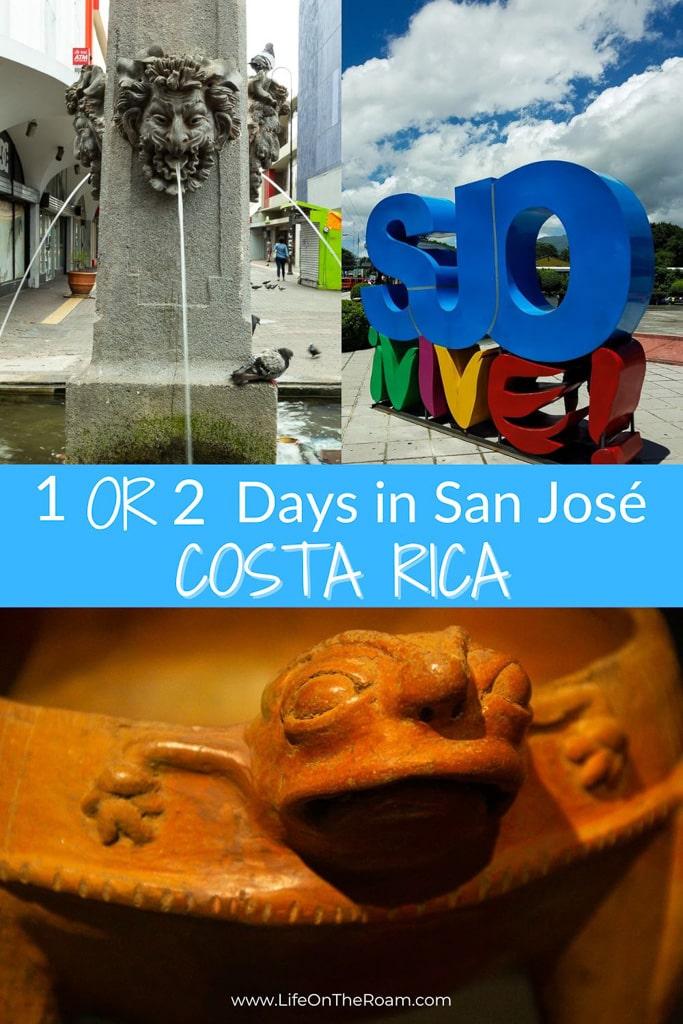
Table of Contents
See America’s Largest Pre-Columbian Jade Collection (and More) at the Jade Museum (Museo del Jade)
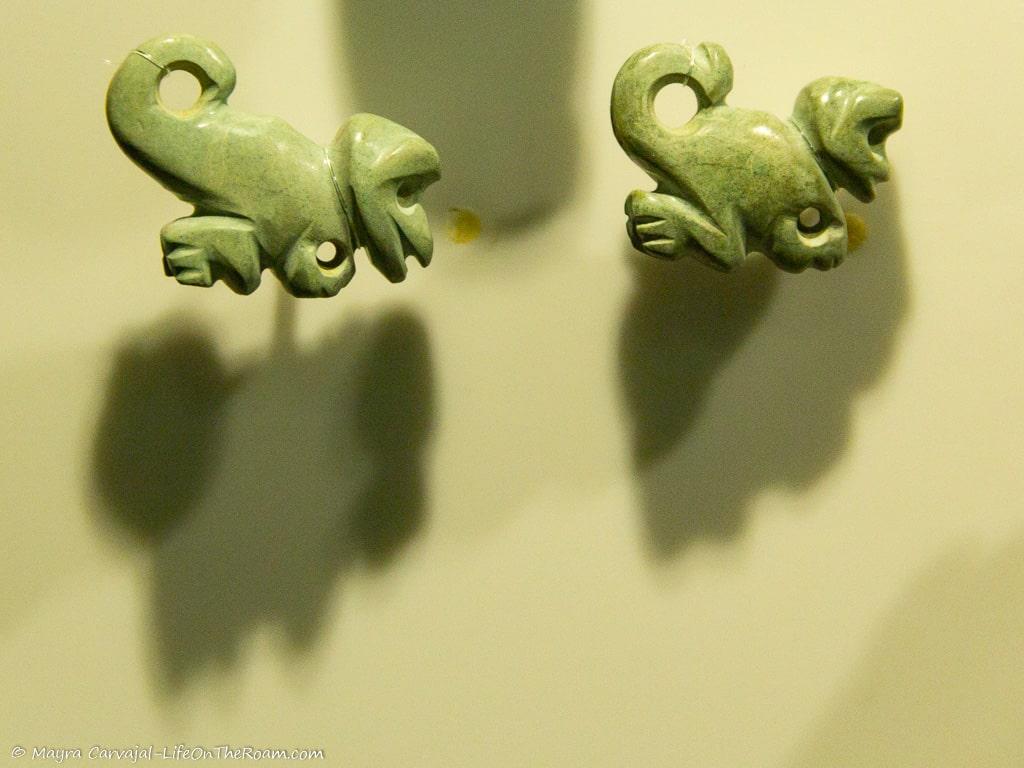
Ooooh, look at this stone! Hmm…what can I make with this?
The Olmecs in Mexico saw a block of jade and asked themselves this question around 1800 B.C.. After polishing the rock they were mesmerized by its shine and all the shades of green, yellow, white, and brown, and used it to produce objects to pay homage to fertility and agriculture.
The same question popped across Asia, Europe and other regions of America where artists made tons of beautiful pieces. In Mesoamerica –Mexico, Honduras, and Guatemala-, shamans (spiritual leaders seen as magicians with supernatural powers) used them in magic ceremonies. Royalty and the VIPs used them to flaunt their social status. Look, I’m rich!
In Costa Rica the jade fever started around 500 B.C..Local artists learned the techniques from the Mayans thanks to the regional trade and created unique pieces that reflected their society and their environment.
To see a sample of the wonderful work they did during the pre-Columbian period between 500 B.C. and 900 A.D., go to the Jade Museum in San José.
This is the largest collection in America comprising more than 100 objects in jade, displayed in an interactive exhibit.
The extensive archeological collection not only includes pieces in jade such as jewelry, discs with glyphs, and animal-shaped ceremonial pieces, but similar objects made with other stones known as “social jade”, such as quartz, jasper, and agate.
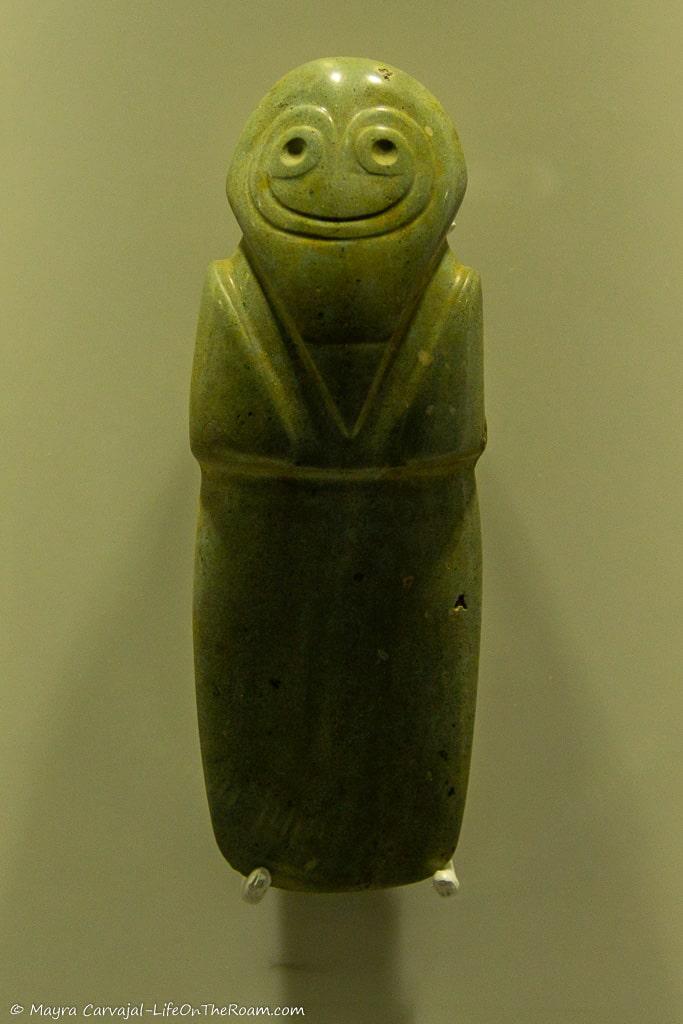
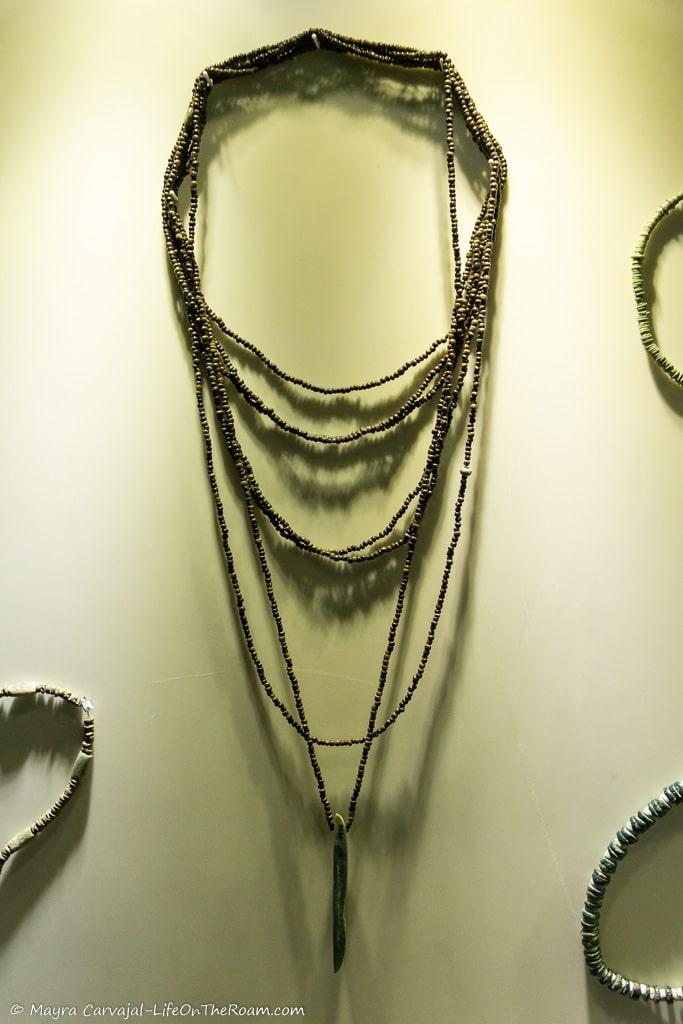
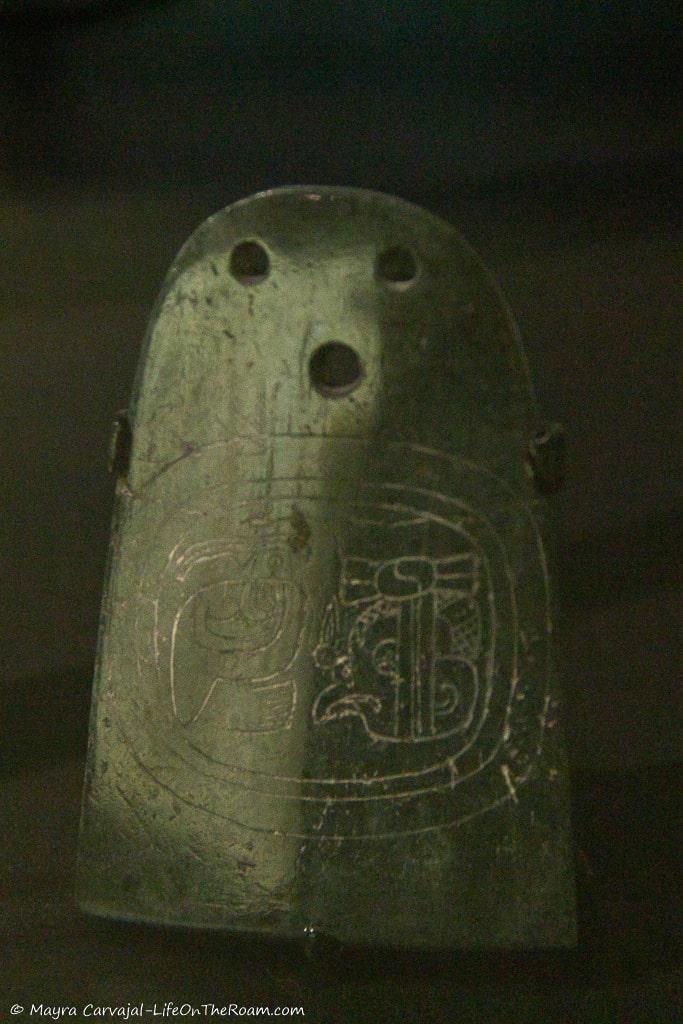
You’ll also see pottery and stone pieces from Costa Rica (and Mesoamerica) that were placed next to jade objects during rituals, celebration of death, passage into adulthood, and other important events such as war and hunting.
There’s an entire room dedicated to shamanism, with figurines depicting the mythical character. People believed shamans turned into jaguars at night and of course, no efforts were made to say No way, I don’t!. Maybe they were too high and they truly believed they did. Maybe.
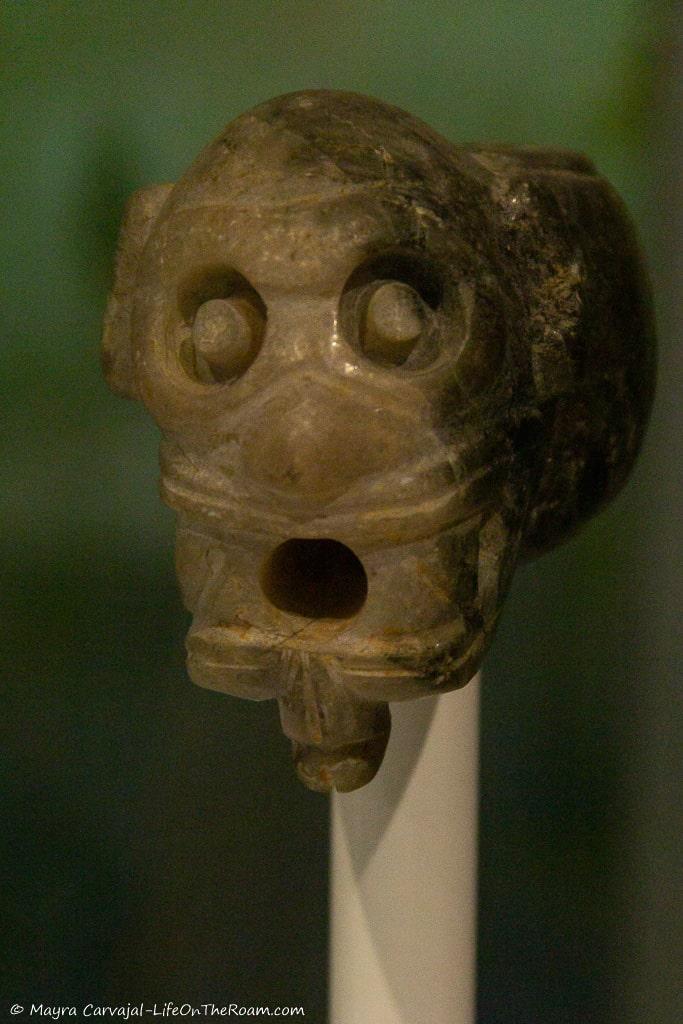
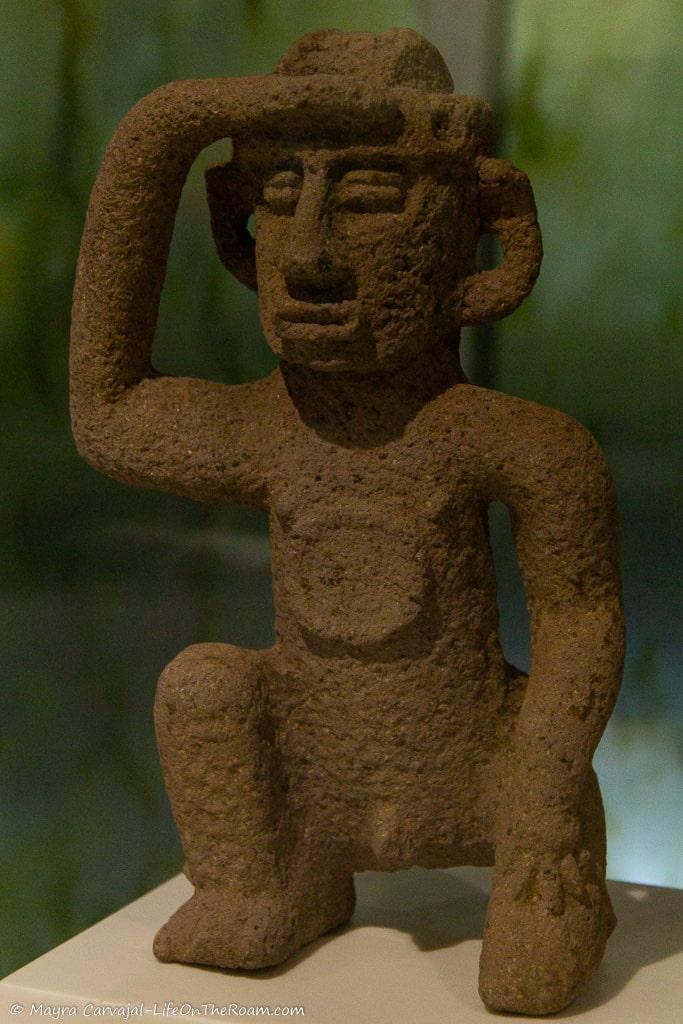
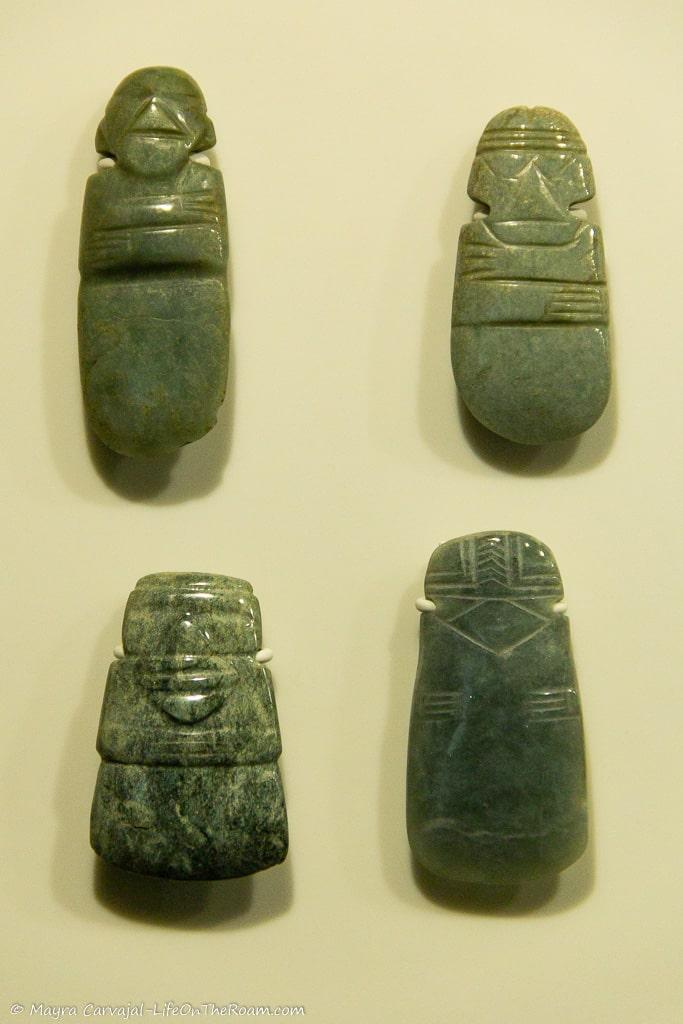
Other objects include things used for their rites: jade amulets with carvings, mortars, smoking pipes, and ceremonial attires.
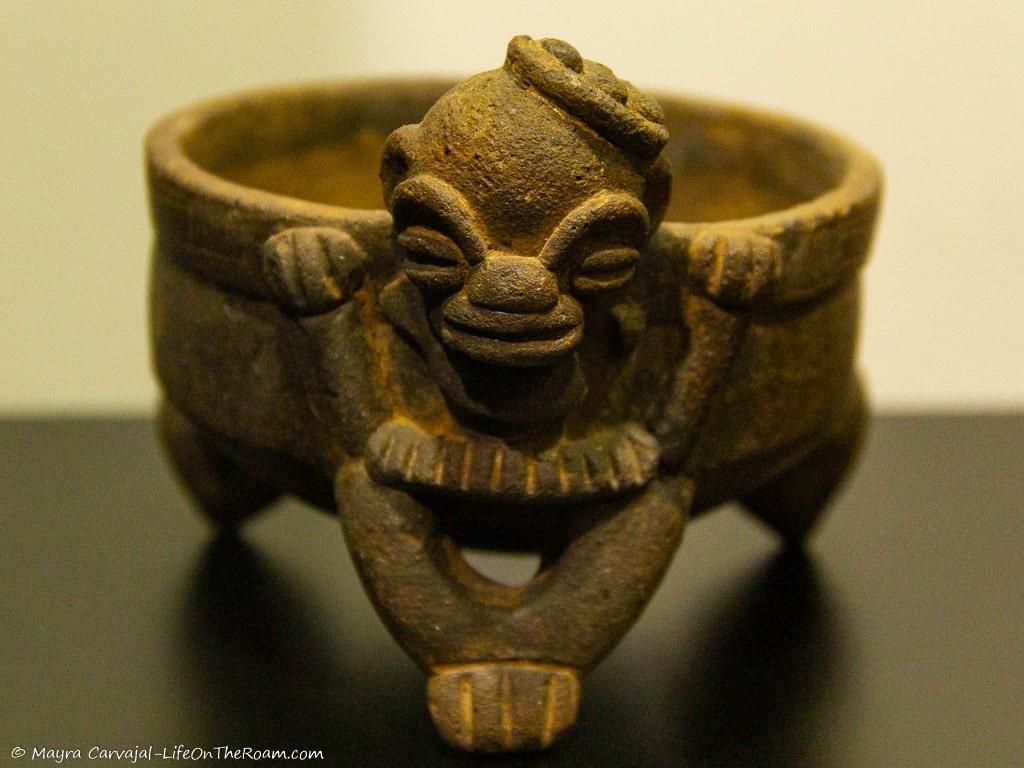

One of the coolest spaces is the Day Hall on Level 3, with a display that transports you to the forest, and with objects depicting the bountiful nature and wildlife variety of Costa Rica: howler and spider monkeys, birds, mammals, reptiles, insects, and aquatic life.

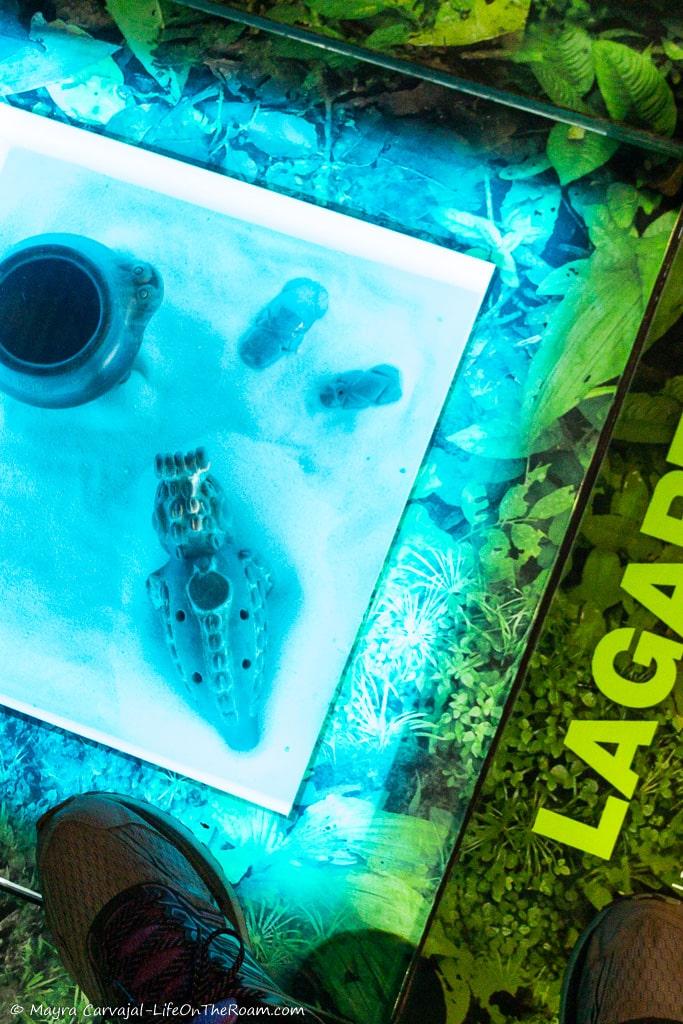
You’ll learn about the relationship between the early inhabitants and their environment, their housing, crops, and daily activities.
Visit the Night Hall to see pieces used for burials and altars, and sculptures depicting the warriors of that time showing their attire and their war rituals.

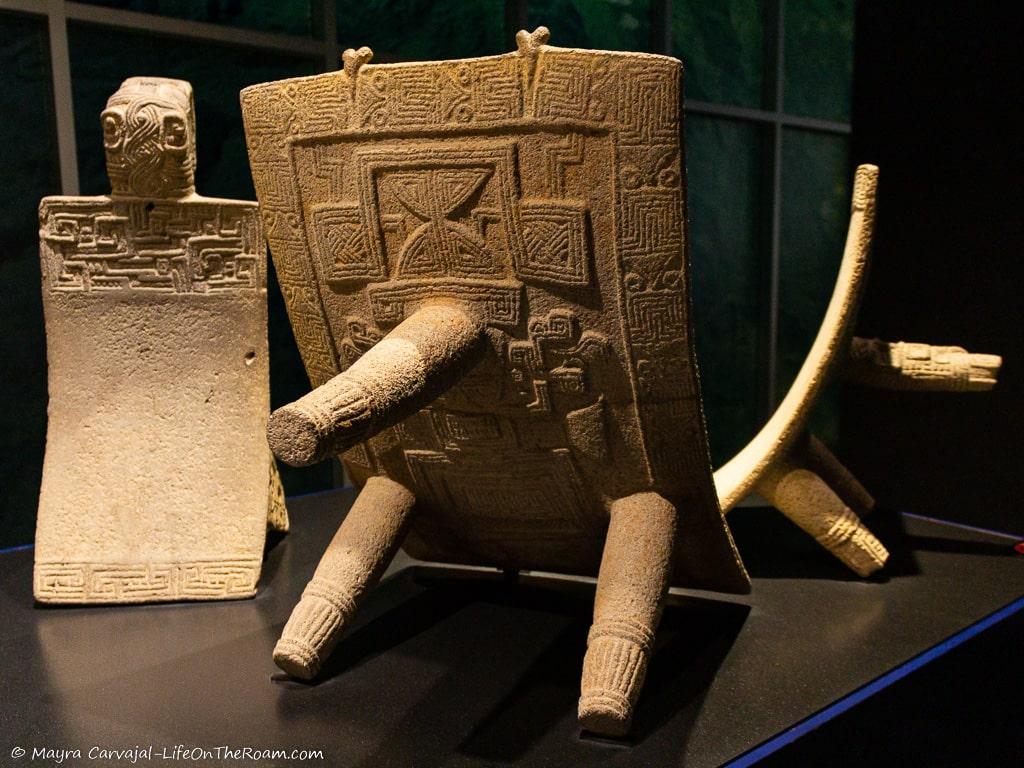


Early Costa Ricans collected trophy heads instead of trophy wives. Losing a battle would cost you your head which would serve as inspiration for sculptures of a head, a headless body, or a bird carrying your head away.
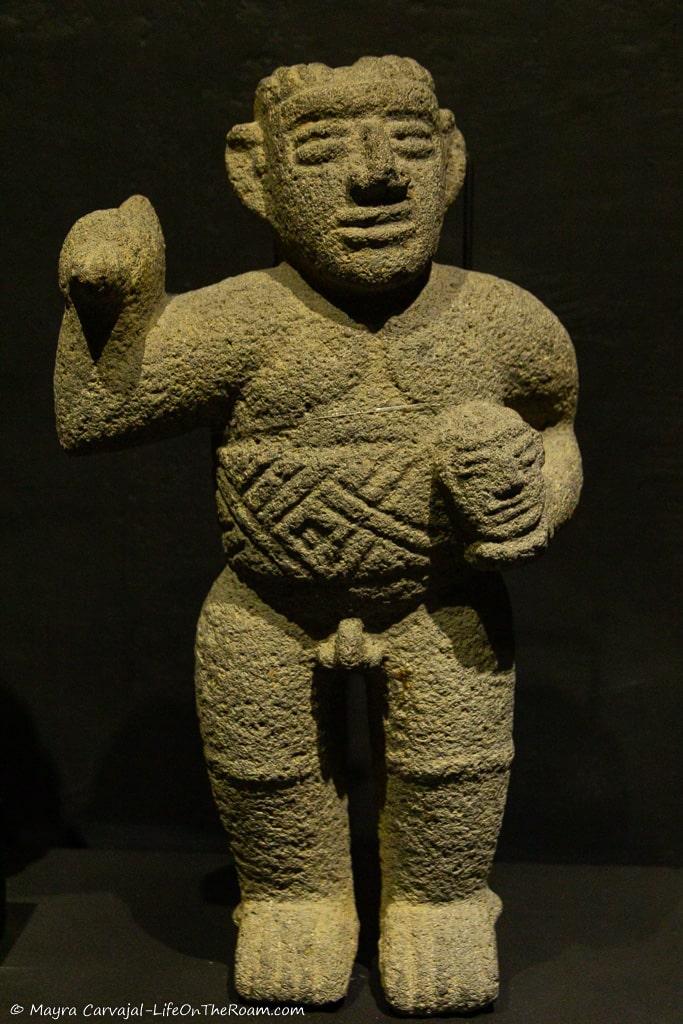
You can also attend concerts and check out temporary exhibits.
Jade Museum (El Museo del Jade)
Central Avenue and Calle 13 (next to Plaza de la Democracia); Open every day: 8AM-5PM; General admission (non-nationals): US$16
Visit the National Museum of Costa Rica
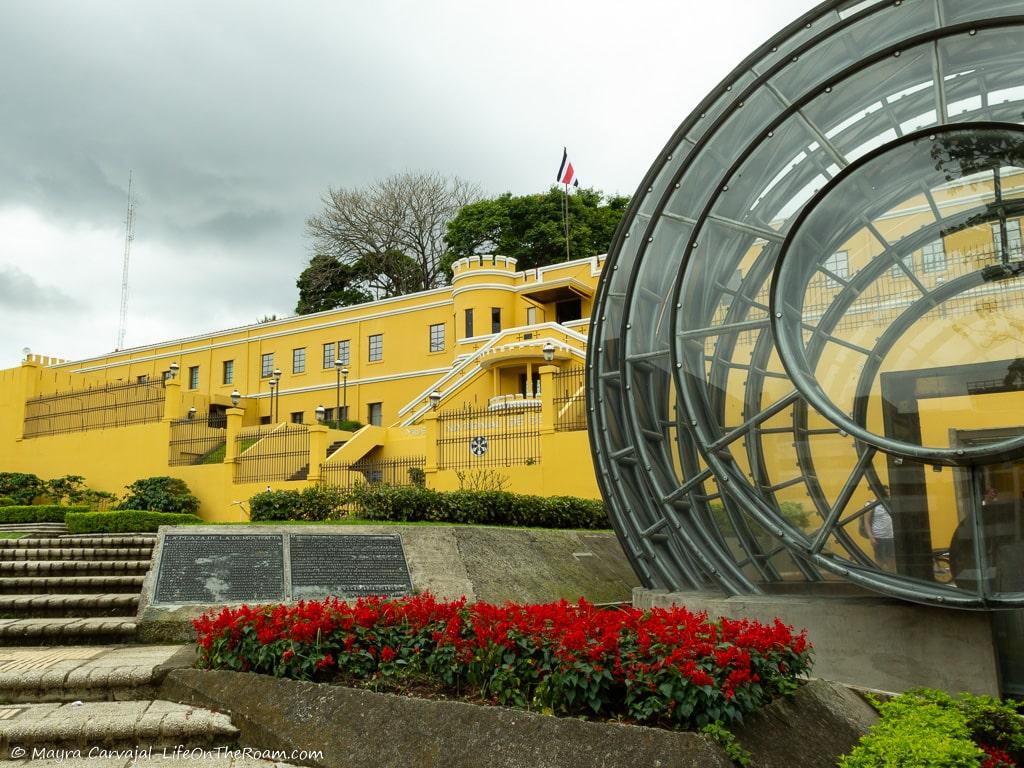
Nature is such a crucial part of Costa Rica’s identity that you can find it even inside a museum in the middle of the city.
Perhaps that’s why it’s not a surprise that, as you enter the National Museum of Costa Rica through its butterfly garden, you’re surrounded by banana trees, palms, and heliconias with butterflies flying all over the place.
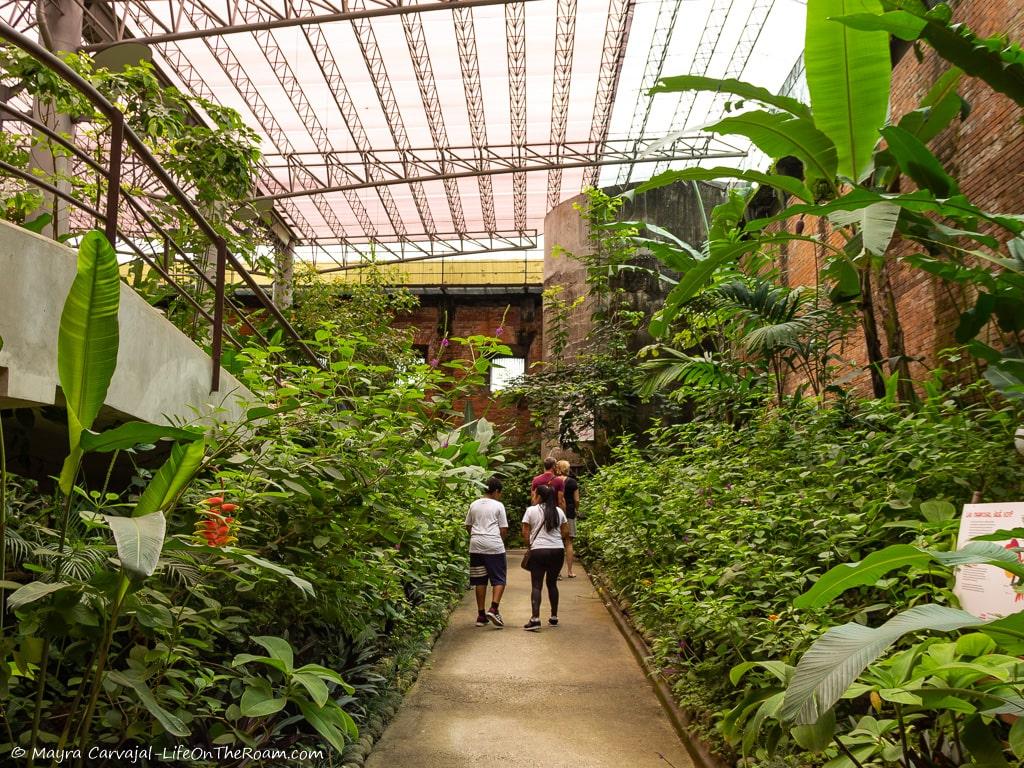
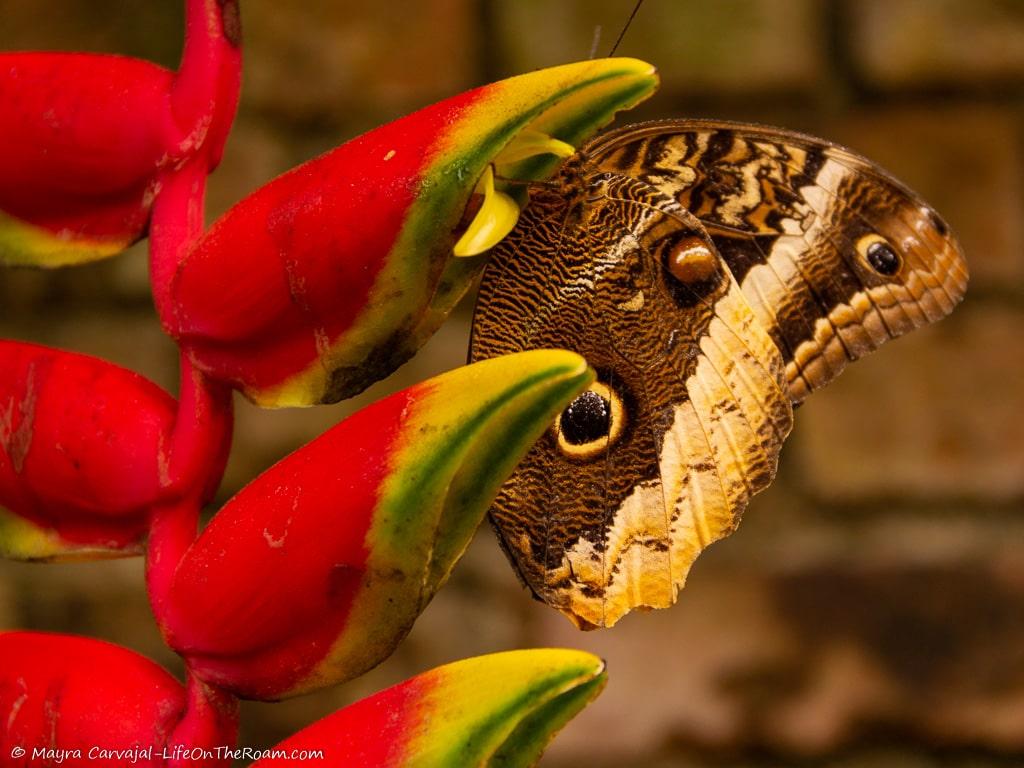
From here you’ll enter another garden with tall trees, agricultural equipment used in the 19th century, and sculptures displayed in the inner courtyard of a building that used to be a military facility up to 1949 (the Bellavista barracks), and a coffee farm in the 19th century.
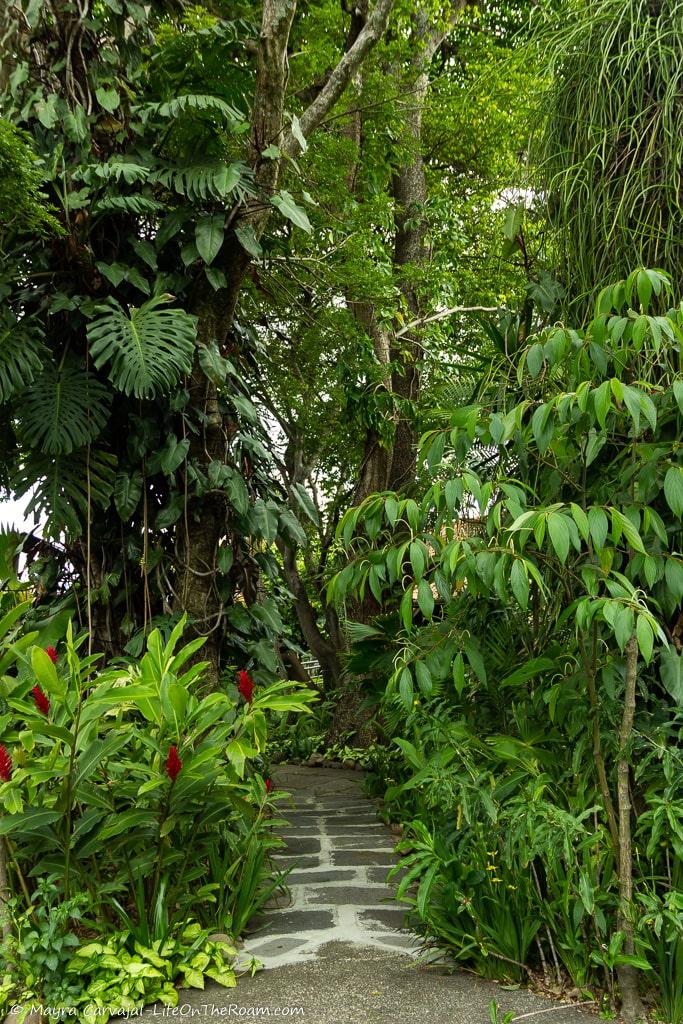
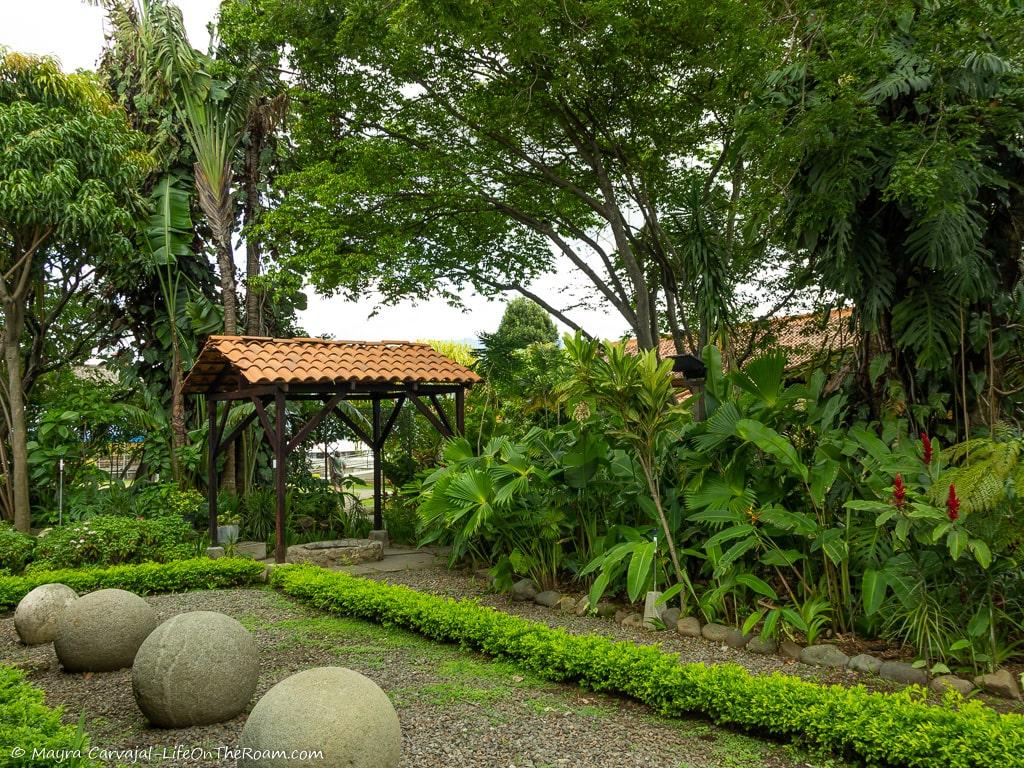
The building bears the historical significance of being a symbol of the abolition of the army in Costa Rica (the country hasn’t had an army since 1949).
It also bears the scars of the bullets fired during the civil war in 1948.
Surrounding the beautiful green space are several exhibit halls: Pre-Columbian history, Costa Rica’s history, and the Commander’s residence where you can see early 20th century furniture.
The pre-Columbian hall takes you all the way back to 10.000 B.C. when the first hunters and gatherers roamed around Costa Rica among giant animals, making the most out of their tools made of stone, bone, and wood.
Around 2,000 B.C. people started to settle, developing agricultural practices and working on pottery, which became more prominent towards 500 B.C. (also the start of a chiefdom society with social rankings). Artisans started creating offerings for burial rituals, such as metates, pieces for shamans to use in spiritual ceremonies (often using animal symbolism), and for people to show off their social status.
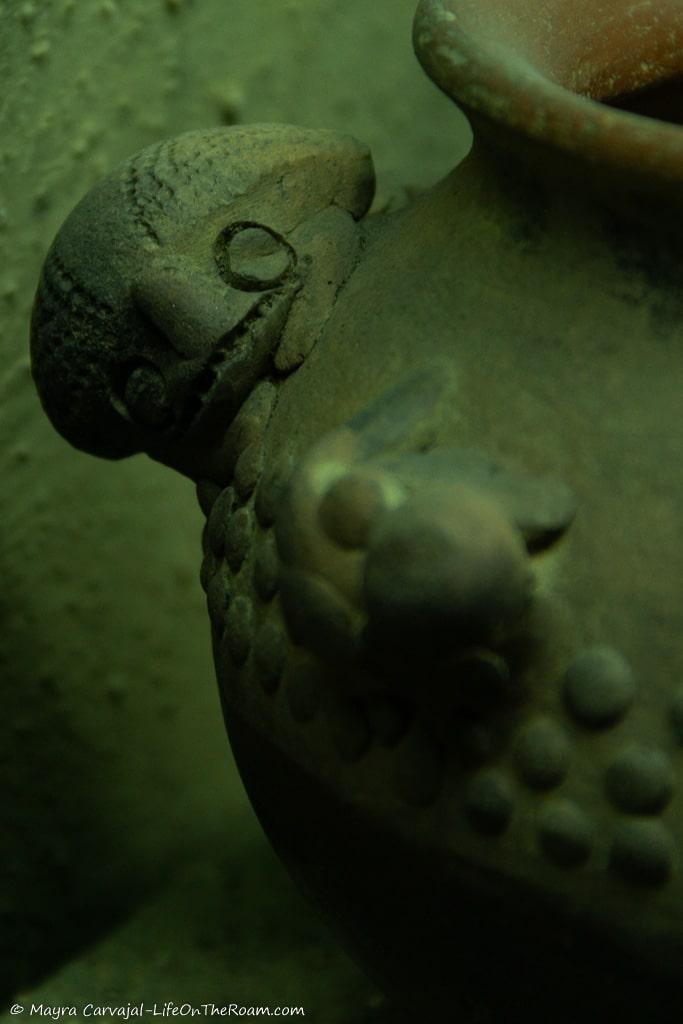
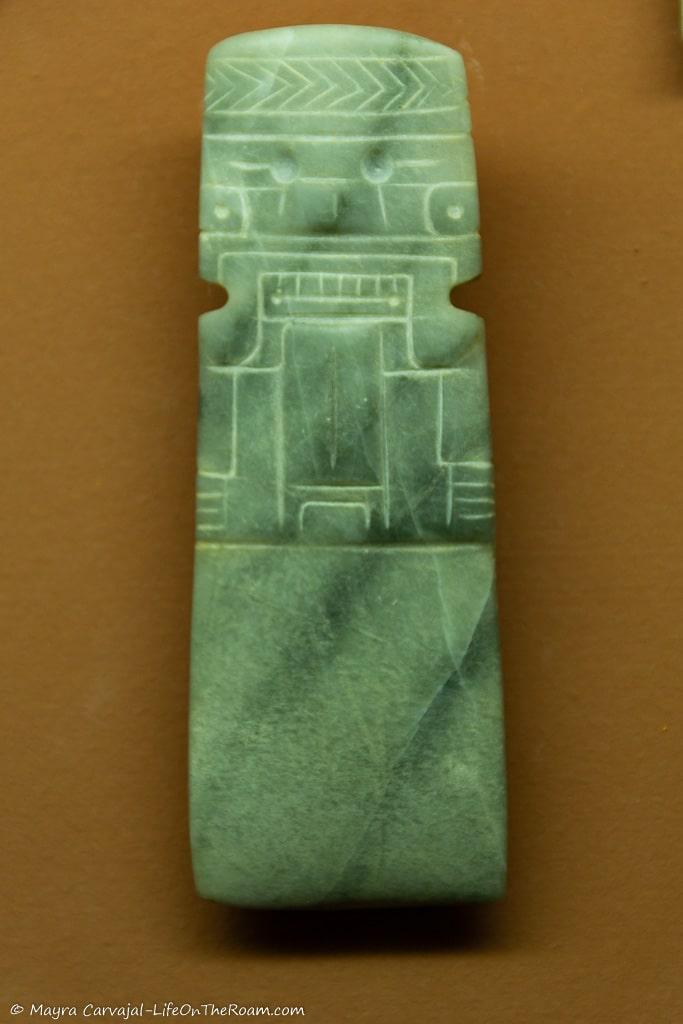
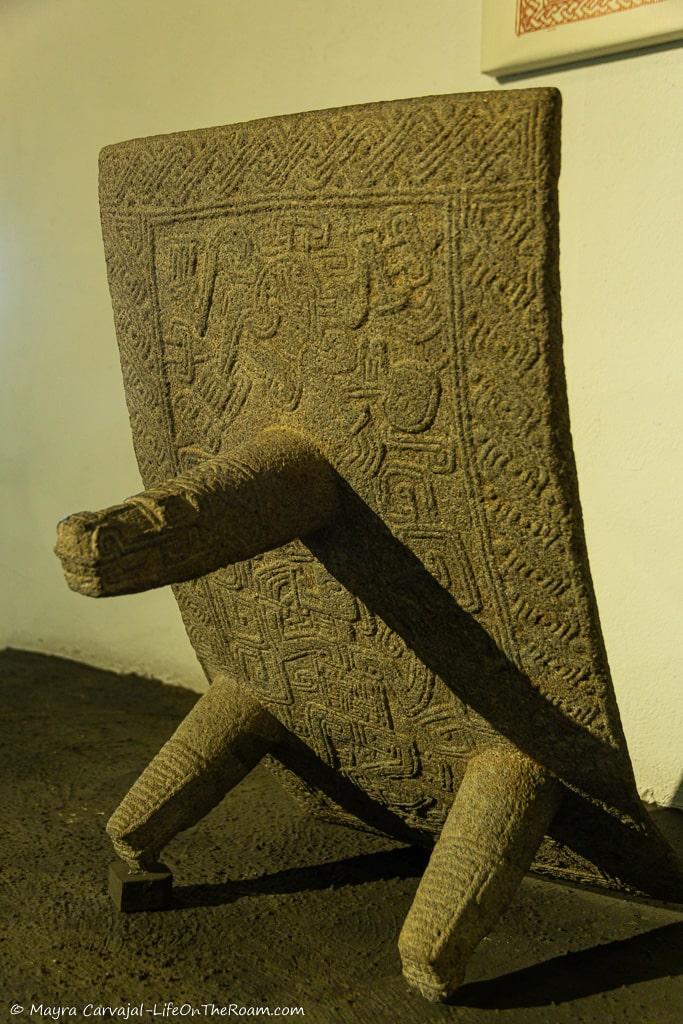
Note: You can find an important collection of jade objects in the Jade Museum, right across the square (totally worth it!).
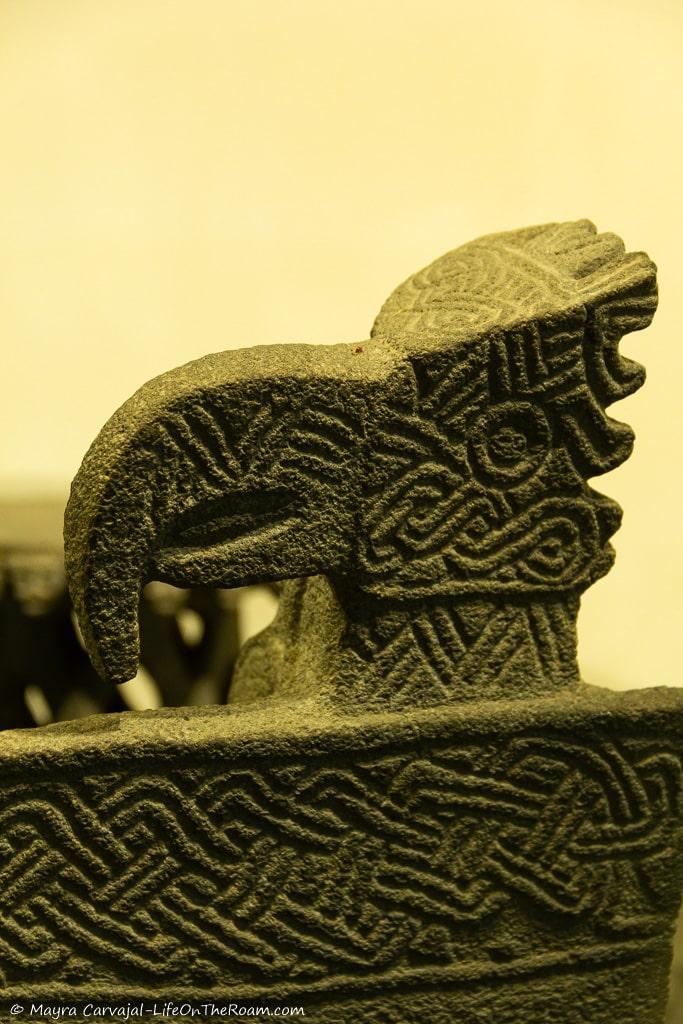
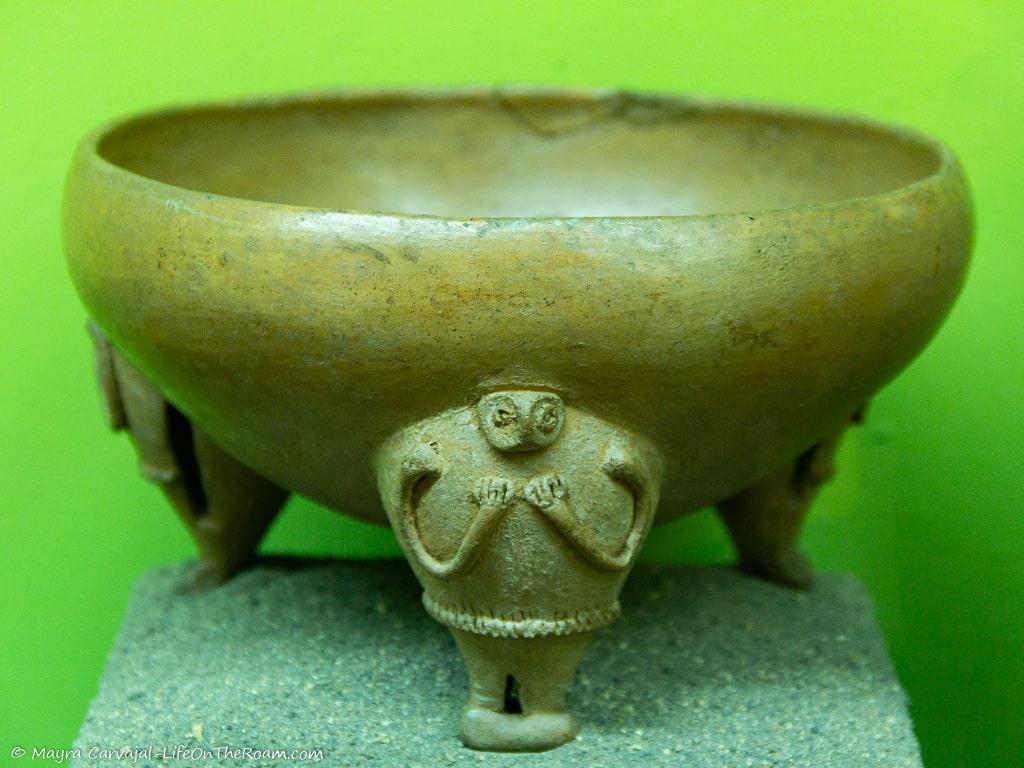
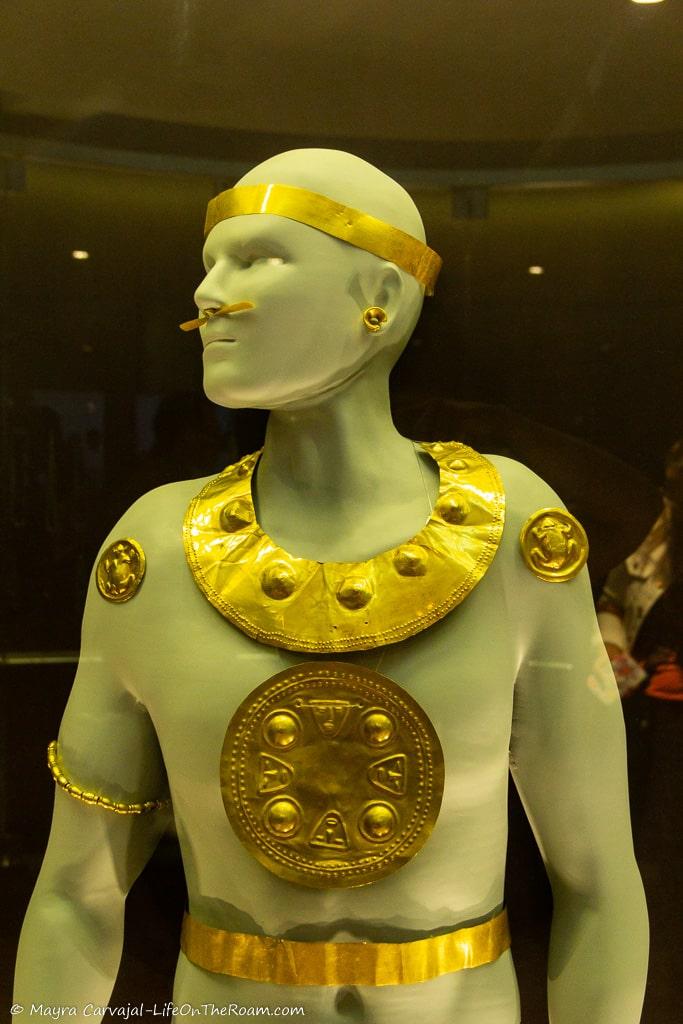
Fast-forward hundreds of years up to the arrival of the European colonizers in the 16th century: an event that would forever change the world of the indigenous population: their land and resources were taken, their population was decimated by diseases and exploitation, and their culture suppressed.
Costa Rica’s history hall covers the period between the Spanish conquest and the creation of the Republic in 1821 when the independence wave across Latin America reached Costa Rica. What did the country rely on to make money back then? Coffee. And to transport the coffee (before cars and paved roads) they would use oxcarts.
Highly decorated ones. This became such a tradition that it was declared a UNESCO Intangible Heritage of Humanity.
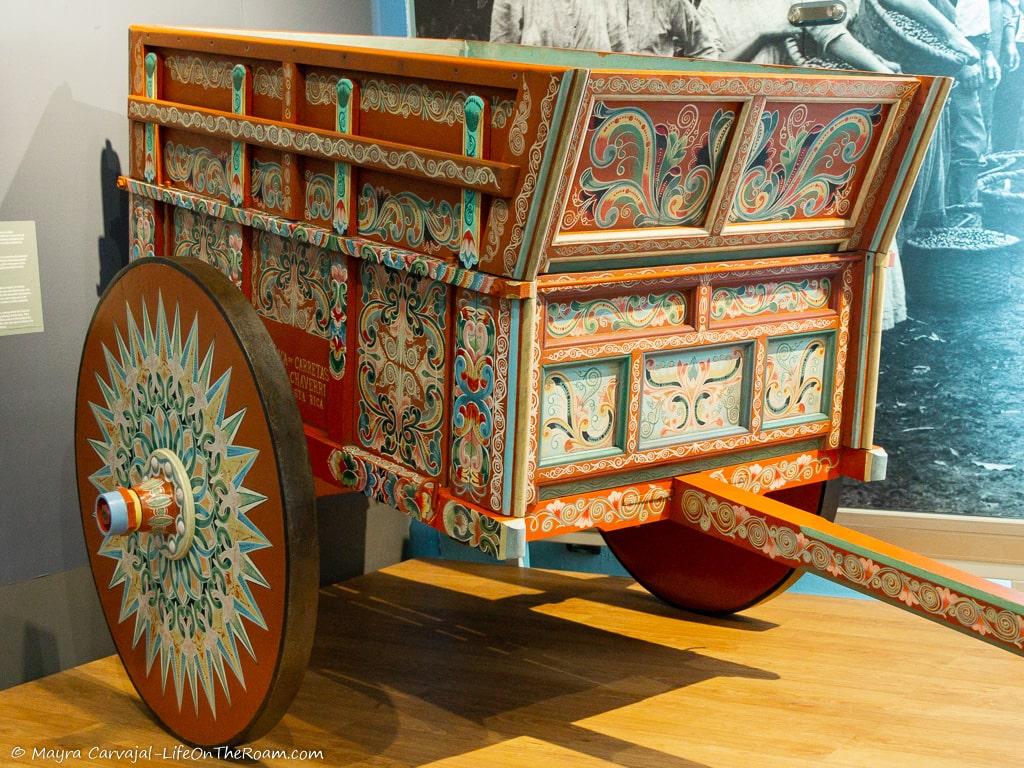
Note: to see more of these gorgeous carts take a day trip to the lovely town of Sarchí, an important arts and crafts centre in Costa Rica where you can see the largest oxcart in the world.
Even though coffee production is still part of Costa Rica’s economy (not nearly as much as in the 19th or early 20th century), today the main activities are tourism and the service sector. The hall display also covers the recent history of the country.
You can also enjoy interesting temporary exhibits.
The National Museum of Costa Rica
Between Central Ave. and 2nd Ave., next to Plaza de la Democracia; Open Tue.-Sat.:8:30AM-4:30PM and Sun.: 9AM-4:30PM (closed on holidays); General admission (non-nationals): US$11
See Wildlife in the Middle of San Jose
While you won’t see as much wildlife as in the jungles of Costa Rica’s National Parks or a sanctuary, you will have the chance to see sloths up in trees, resident and migratory birds, insects and a rich flora.
The location is the forest of the University of Costa Rica campus, where you can take a 2.5-hour guided tour with biologists who will share their extensive knowledge on the surrounding nature.
Telescopes or binoculars are provided and the guides speak English.
Book this nature tour in the city, with a rating of 4.9/5 based on more than 560 reviews.
Walk Around the Sculpture Garden at the Museum of Art of Costa Rica (Museo de Arte Costarricense)
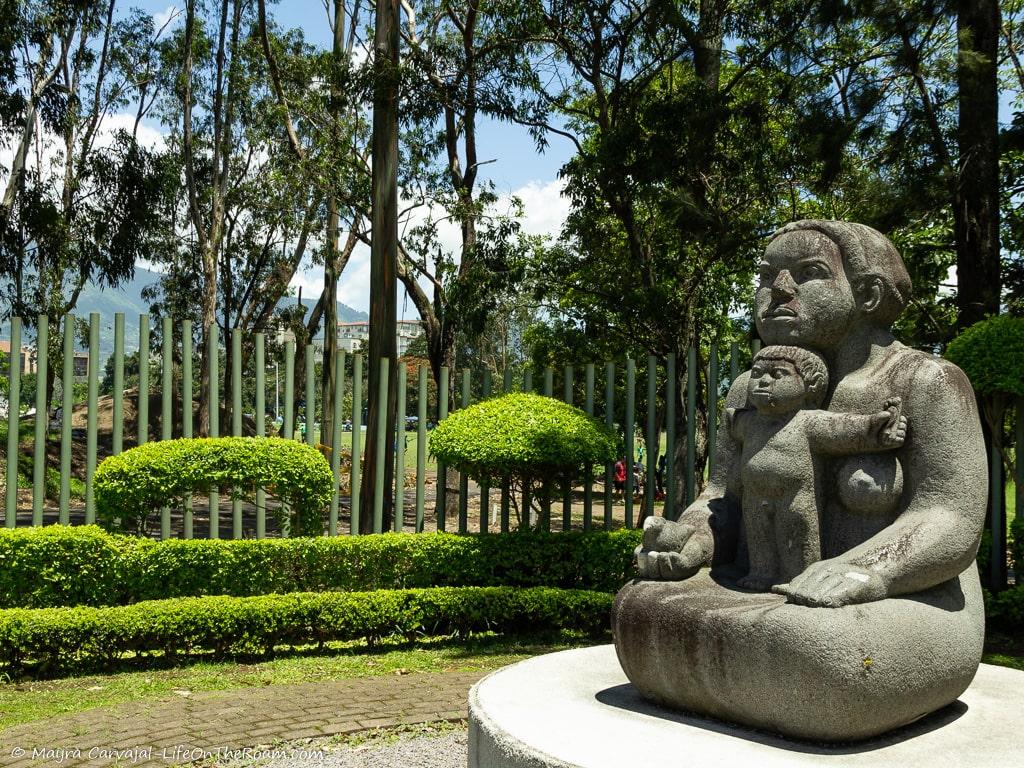
The Museum of Art of Costa Rica building was the country’s first international airport from 1940 until 1955. In 1978 it became a museum with a garden where you can admire monumental sculptures from Costa Rican artists.
Inside the small museum, you’ll find a wide range of artwork from local and international artists including painting, sculpture, and photography from the 19th and 20th centuries, along with temporary exhibits.
You can’t miss the Salón Dorado (Golden Room) on the second floor, a lounge used for receiving diplomats when they landed in Costa Rica. If their goal was to impress visitors, they did a good job.
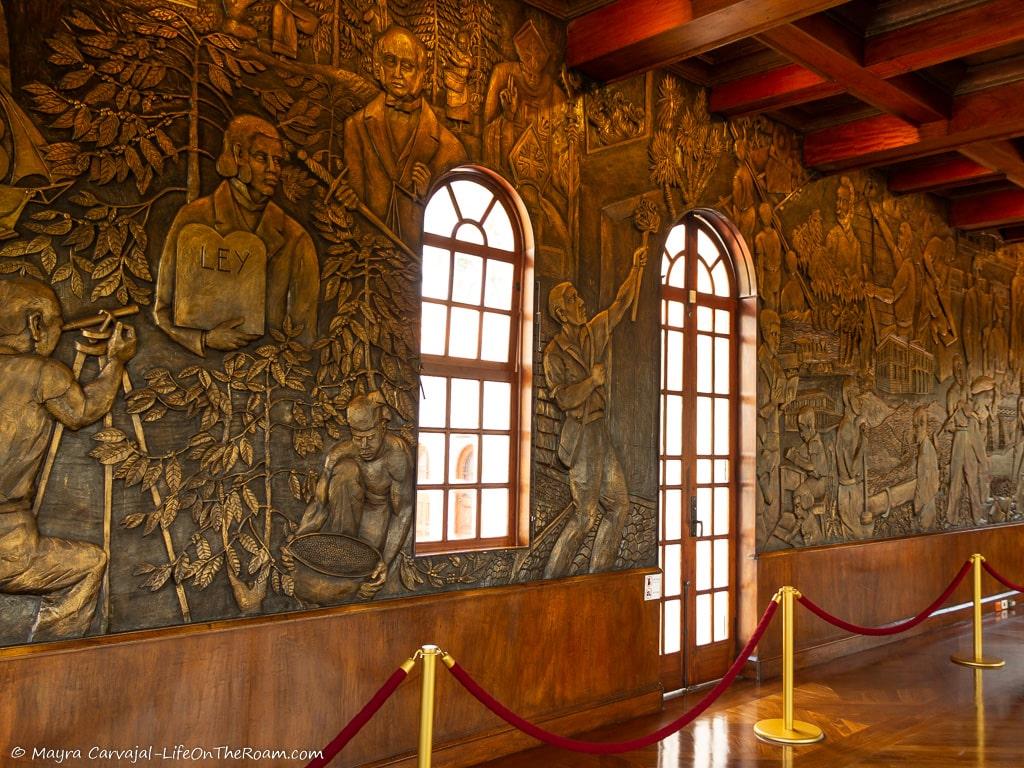
French artist Louis Féron covered all walls with stucco and carved a bas-relief to create a mural depicting the history of Costa Rica from the pre-Columbian era until 1940. The name of the room comes from the bronze paint covering everything. Stunning artwork!
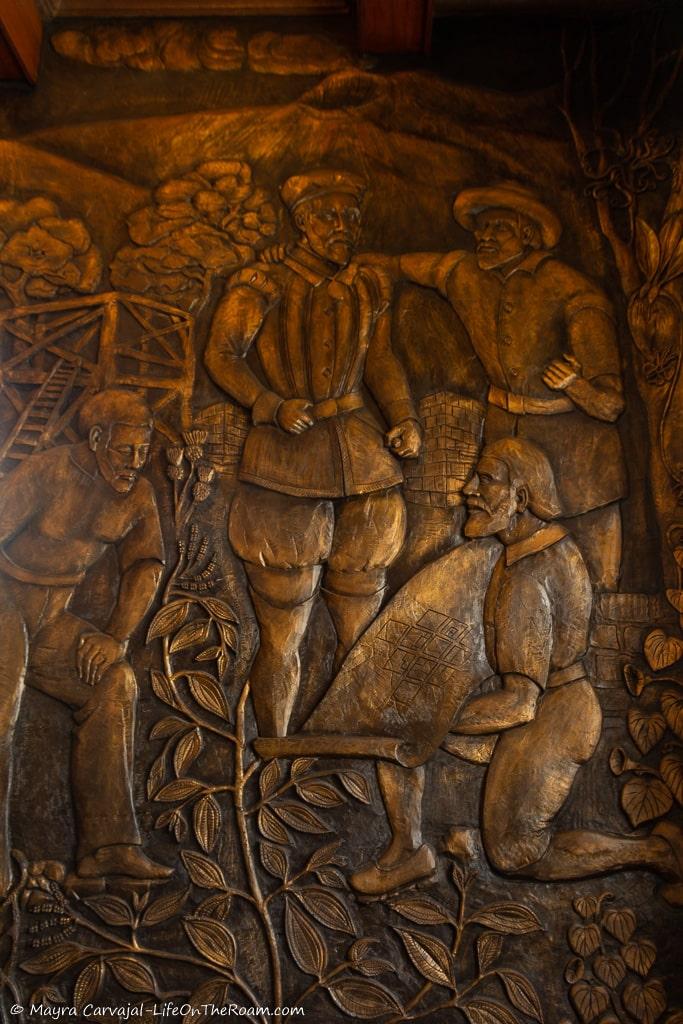
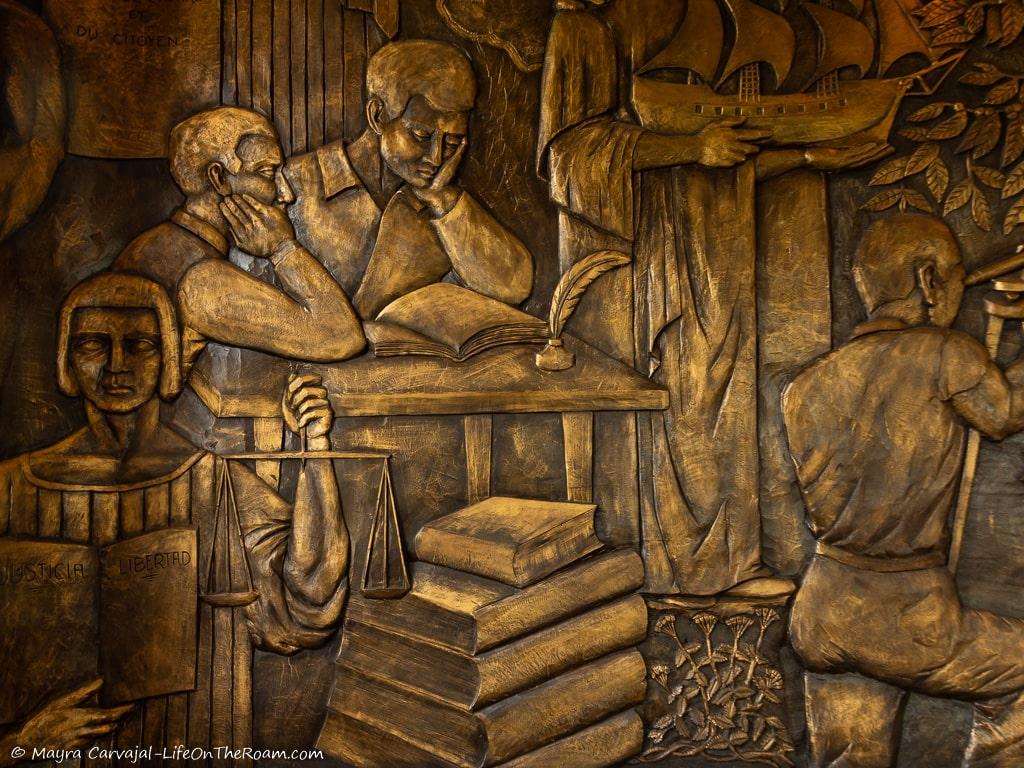
If you liked the mural, check out the gold necklace from the same artist, inspired by the murals he created.
Also, enjoy the temporary exhibits that may be on during your visit.
The Museum of Art of Costa Rica
La Sabana Park and Calle 42; Open Tue.-Sun: 9AM-4PM; Free admission
Feel the Gold Rush at the Pre-Columbian Gold Museum (Museo del Oro Precolombino)
Lots of shiny stuff in here with a collection comprising more than 600 pieces in gold made during the pre-Columbian era, along with pottery from different periods.
In addition to objects made with the mineral that became the obsession of the colonizers, you can learn about the history of Costa Rica and the life of its early inhabitants.
Museum of Pre-Columbian Gold
Central Ave. and Calle 5; Open every day: 9:15AM-5PM; General admission (non-nationals): 8400 colones
Admire the Architectural Gem of San Jose: The National Theatre of Costa Rica (Teatro Nacional)
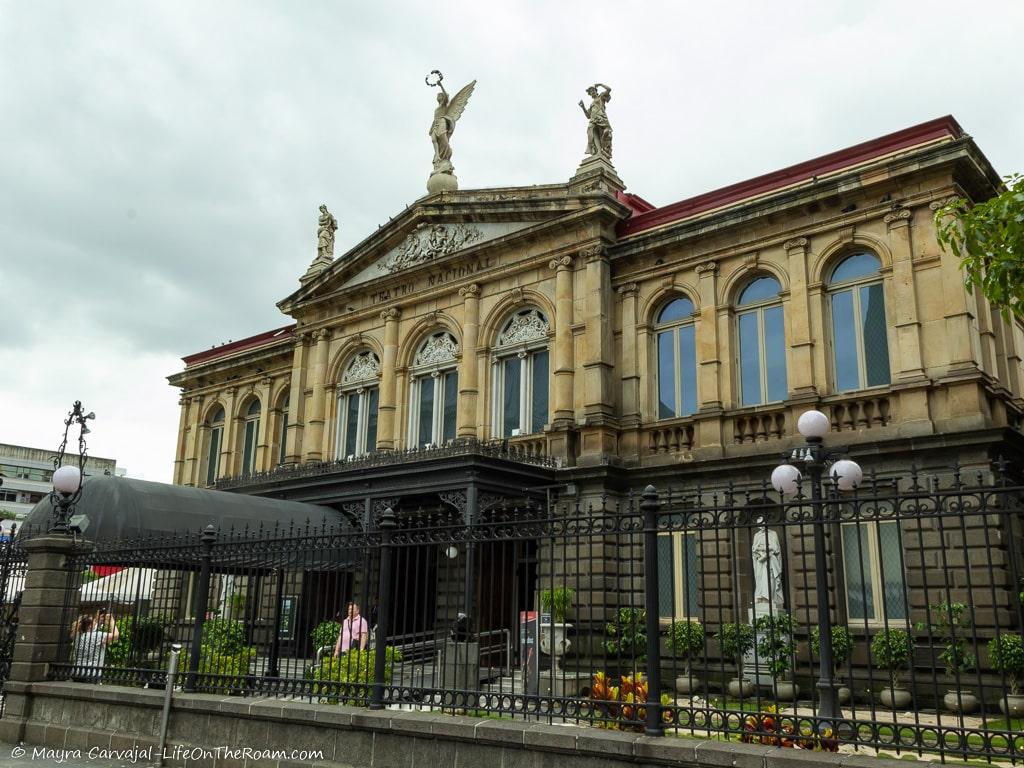
As you walk through Central Ave. you can’t help to stop and see this jewel from the late 19th century, built in neo-classical style.
The money to erect what it’s considered the most beautiful building in Costa Rica came from a coffee tax.
You can take a guided tour to see the interiors and all the paintings and sculptures adorning its halls (or buy a ticket to attend a performance).
The theatre is located on 2nd Ave. with Calle 5; Tours run every day: 9AM-4PM, every hour (available in English and Spanish); Cost (non-nationals): 3,500 colones.
Go on a Food Tour at the Markets and Make Your Own Chocolate Bars
Wondering how that weird-looking fruit might taste? Or how do you eat it? This is your chance to try a variety of fruits and veggies as you walk around two markets in San José.
The guided tour also includes a short walk around nearby streets to learn about the history and culture of the country, sampling of local treats, coffee and ice cream, and a mini workshop where you learn how to make empanadas. It lasts 3.5 hours.
Book this food tour, with a rating of 4.9/5 based on more than 1,200 reviews.
Chocolate lovers in the house? If you raised your hand you’ll not only have the chance to learn about how the cacao beans turn into chocolate, but you’ll also taste chocolate products and create your own bars at a factory in San José.
Chocolate-making workshop: have fun combining a variety of toppings and fillings and packaging your bars to take them home with you.
Sign up for this hands-on workshop, with a 5-star rating based on more than 40 reviews.
Check Out the Art and Monuments Around Downtown San José
Walk around Central Avenue (where most museums are located) to find many sculptures and landmarks.
Close to the intersection of Central Ave. and Calle 14 you’ll meet Al Viento, a nearly 3-metre tall sculpture by local artist Manuel Vargas, representing the determination of Costa Rican women, standing tall in the face of adversity. No hurricane is taking this babe down!
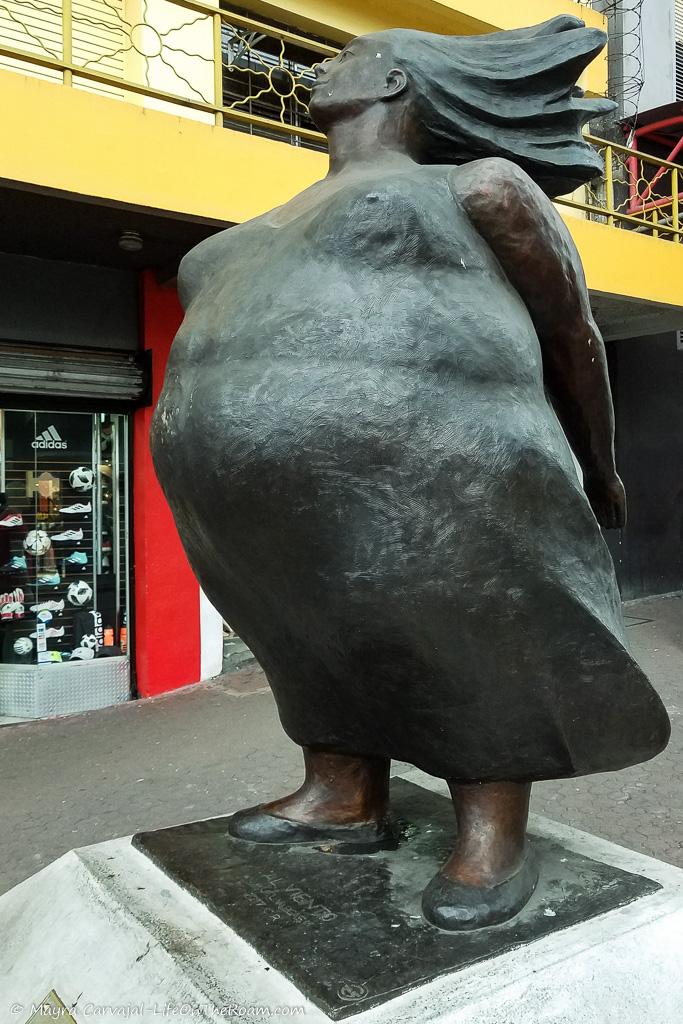
Head East on Central to find El Monumento al Zaguate by Francisco Munguía. Five adorable iron sculptures paying homage to street dogs. Often hungry, abused, and neglected, the dogs represented here had a happy ending finding a forever home with the artist.
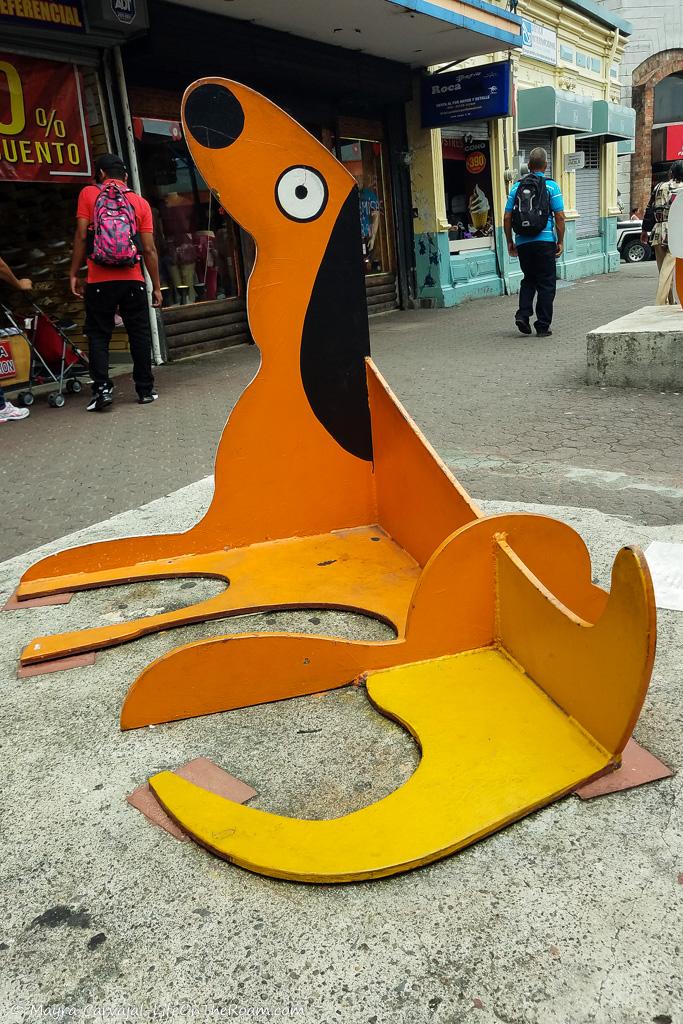
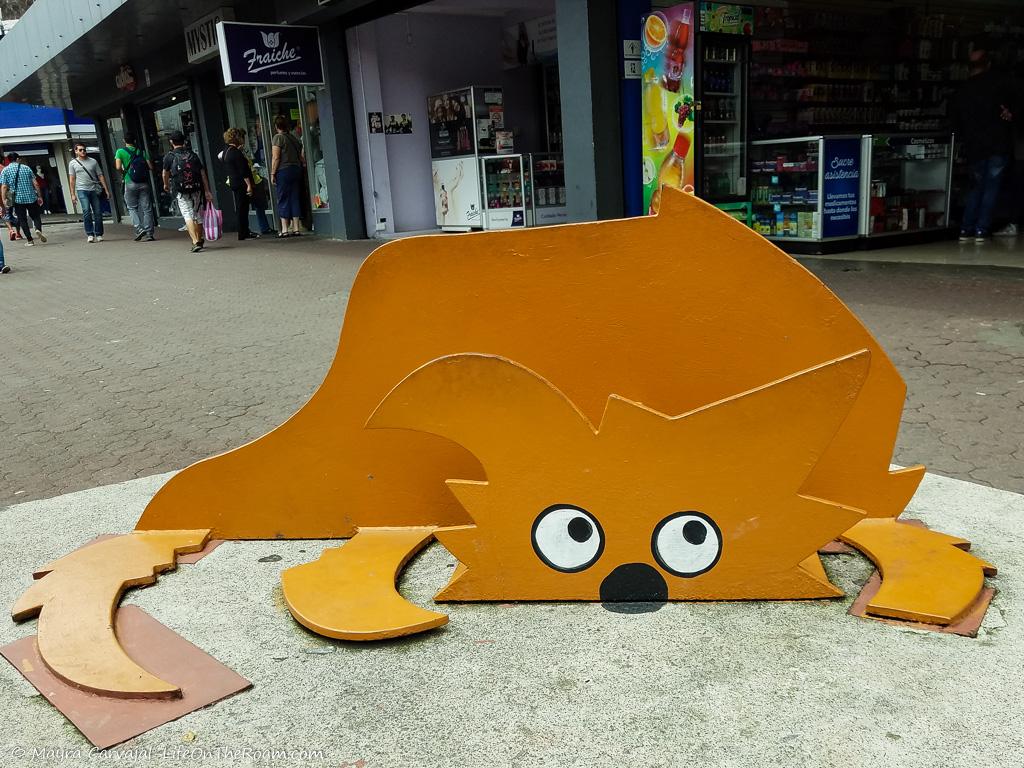
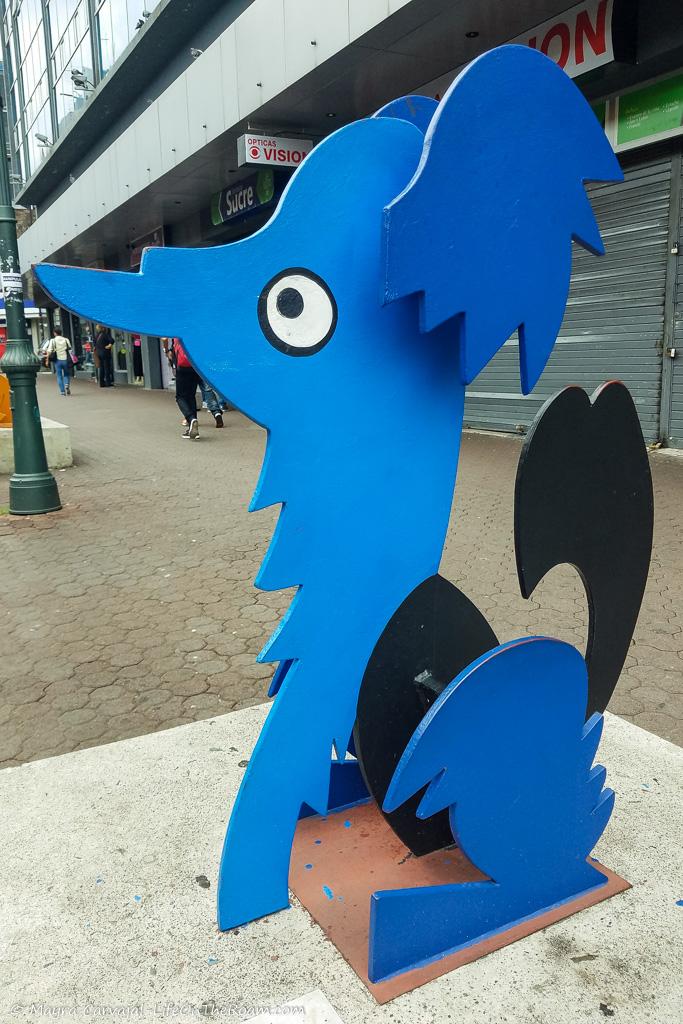
These sculptures sit in front of the San José Central Market, the largest market in San José, dating back to 1880. If you’re a fan of indoor markets you’ll find all sorts of stores, local eateries (called sodas), and handicraft stands.
Further down Central Ave., you’ll find La Chola. The smaller sister (around 1.95-metre tall) of the Al Viento lady (by the same artist), honouring women’s strength and their champion role in the family.
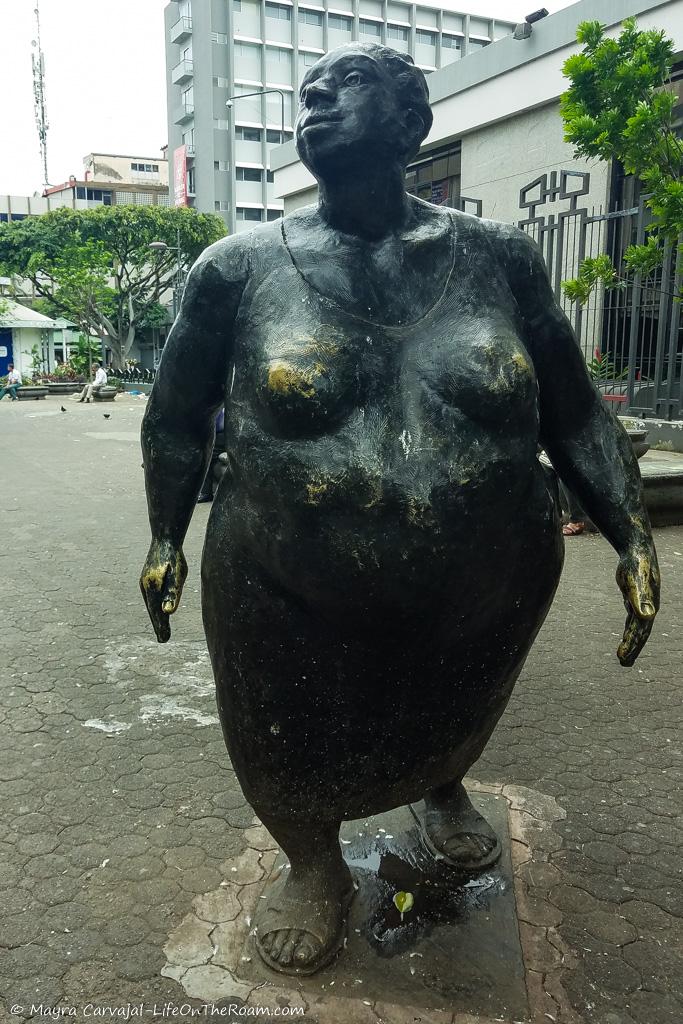
Turn right and walk one block south on Calle 2 until you reach 2nd Ave. where you’ll find Central Park (Parque Central) and several monuments. Many events take place here so you may be able to catch a performance.
Across the street, you’ll see the Metropolitan Cathedral of San José, rebuilt in the late 19th century, in neoclassical style.
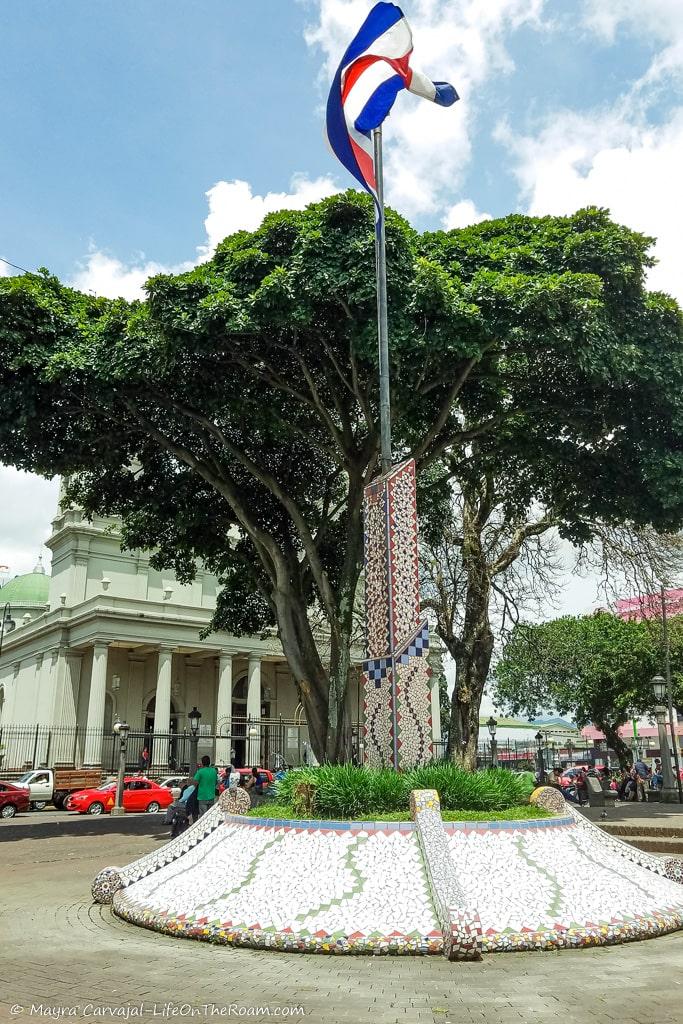
One block east from here, after reaching the magnificent National Theatre of Costa Rica, walk north to Plaza de La Cultura. This is a lively square where you may also see performances and outdoor exhibits, check out the Fountain Clock on Central Ave. (El Reloj de la Fuente de la Avenida Central), and visit the Pre-Columbian Gold Museum.
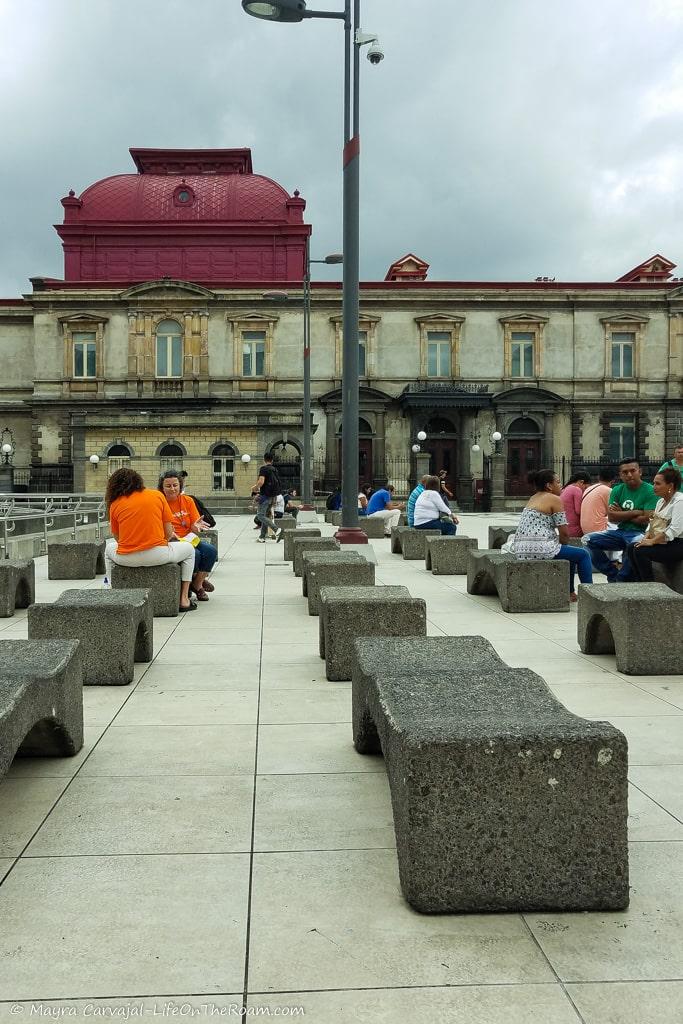
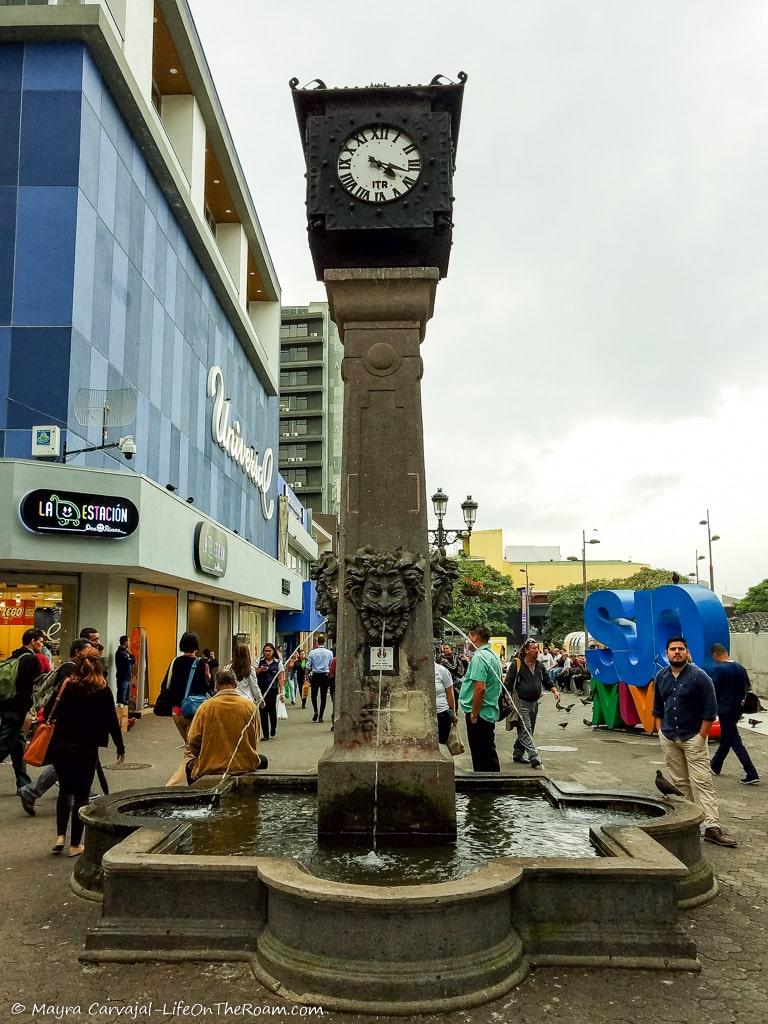
As you keep walking on Central Ave. you’ll see more outdoor sculptures (I loved the cow!) until you reach Plaza de la Democracia.
The multilevel square is surrounded by two major museums (the Jade Museum and the National Museum of Costa Rica), and it’s another location where you may find a cultural event going on.
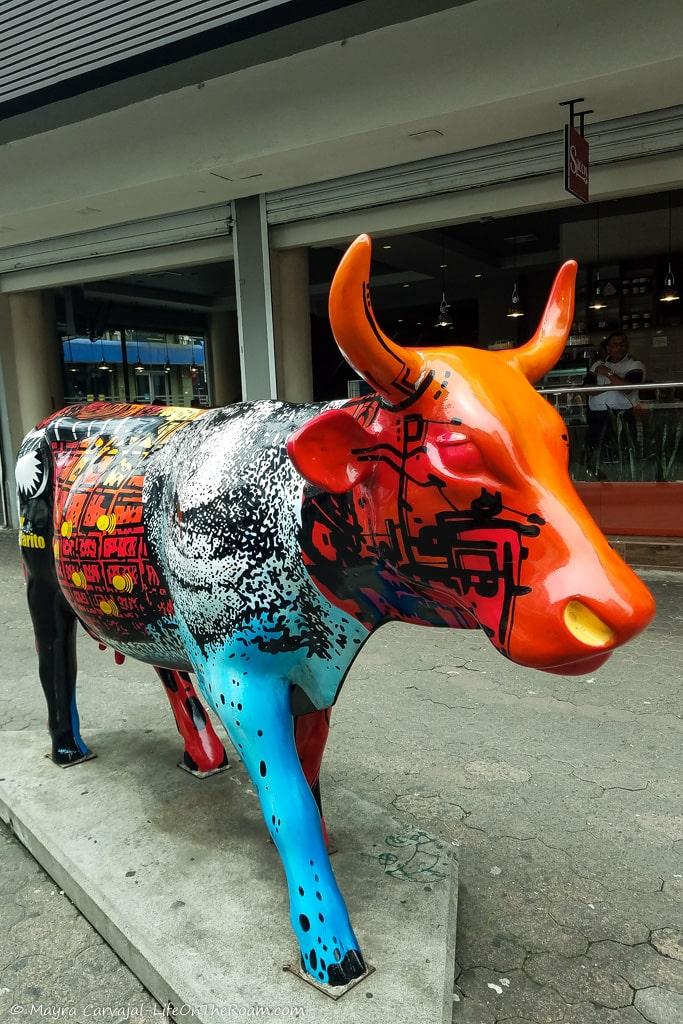
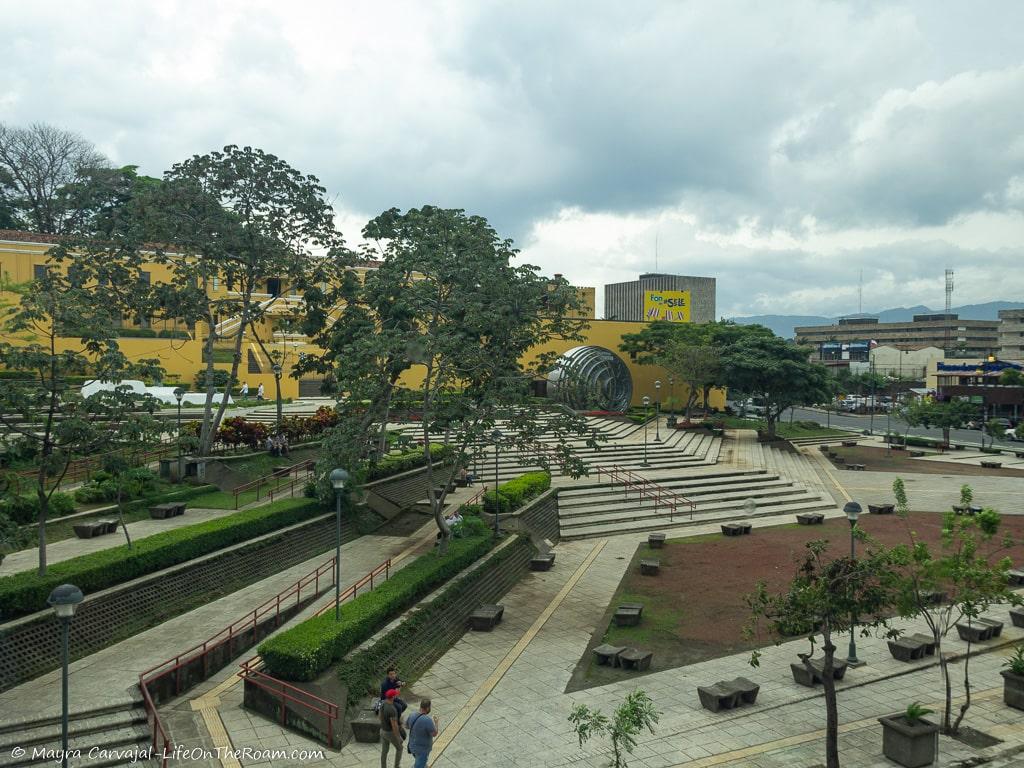
Walk to the glass and metal sphere next to the National Museum to see a pre-Hispanic stone sphere. One of the many carved by the indigenous population of the southern region of Costa Rica.
Archeologists aren’t 100% sure of their function or significance, but they think the stones might indicate social status, landmarks, or map astronomical events and constellations when grouped in a special arrangement.
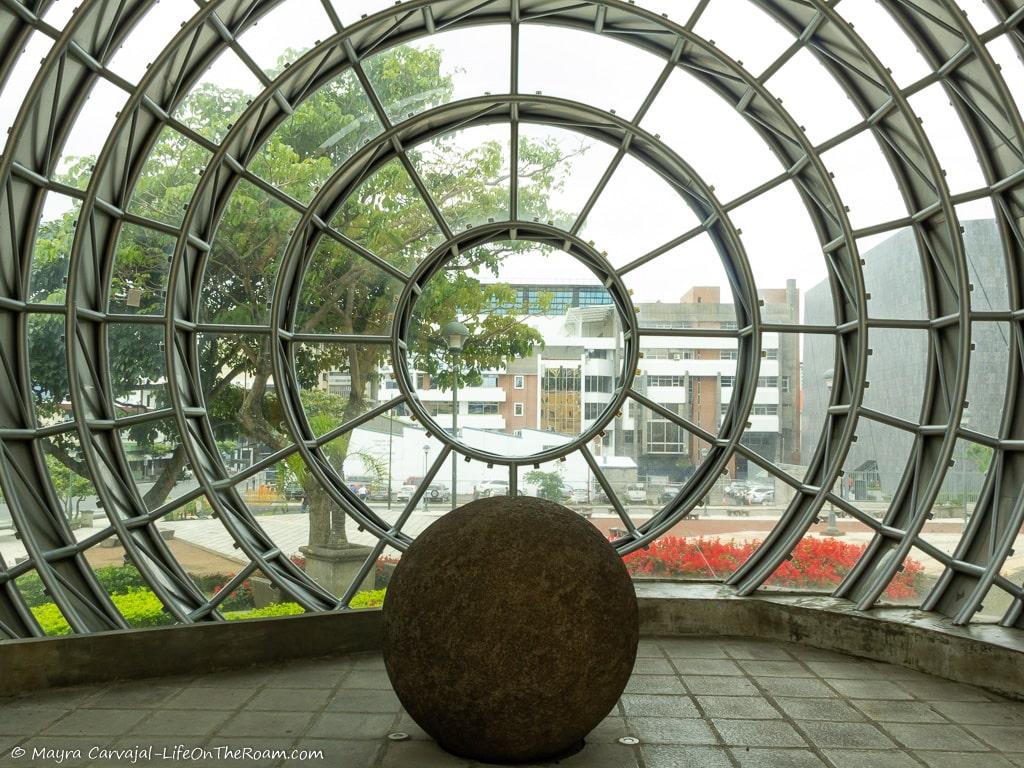
The largest stone found to date has a 2.66-metre diametre.
From here take a few steps to 2nd Ave and walk one block east to Calle 17. Across the street, on the south side, you can find tons of handmade handicrafts in Chietón Morén, a colourful house where 20 indigenous groups from Costa Rica exhibit their work and where you can learn about their culture. You can sign up for workshops or take home some beautiful items. They’re closed on weekends.
Our last stop is at City of Color Murals on Calle 17 (walk north back to Central Ave.), where you can see some cool street art.
Getting Around Downtown San José
If you’re going to spend one or two days in San José in the downtown core the best way to get around is on foot. The area is walkable and most of the attractions I listed here are within walking distance of each other so you won’t need a car.
Is San José Costa Rica safe?
Like most big cities, there are some safety precautions you must take while visiting San José. The areas around the major museums and attractions are deemed safe during the day as they’re busy with lots of people around.
Still, petty theft is an issue (as in most cities). Don’t go out with jewelry and expensive items and be vigilant at all times, especially around crowds. Don’t walk down empty allies.
Take normal precautions when you walk around during the day, but avoid going out after dark and stay away from the parks at night. If you want to wander at night there are guided tours and some even include food tasting.
Where to Stay in San José
If you’re spending one or two days exploring San José you may want to stay in a good quality hotel downtown with a central location where you can walk to the museums and attractions.
Downtown San José is sketchy after dark so I’ll say it again, location is important.
A good option, right in the heart of the city and mere steps from the Museum of Gold and the Cathedral is Gran Hotel Costa Rica, a 4-star hotel with a rating of 8.7/10 based on more than 1,050 reviews.
Next time you’re in Costa Rica, give San José a try. It’s a wonderful opportunity to learn about the history of the country and experience it beyond its fascinating landscape.
RELATED POSTS
BOOKING FLIGHTS AND ACCOMMODATIONS
Book your flight without losing your shirt
We check Momondo to find great deals to book our flights. Also, check Great Escape: it combines the listings from Expedia, Kiwi, Kayak, (and Skyscanner on the premium service) to find the best airfares.
To find a place to stay for less
Booking.com: this site combines everything under the sun. You’ll find hotels, apartments, B&B, hostels, rooms, etc., with all sort of filters to make your search a breeze.
Hotwire: the first site I check when we plan to stay at a hotel for a few nights. You can save anything from 20% to 60%. Use the search filter to find what you want and you’ll end up with three listings that match your criteria. You’ll know which one you’ll get after you book. If you can handle a little bit of uncertainty you can score big savings.
House Sitting: you take care of people’s pets and house for free while staying for free. It’s the closest thing to experiencing a place “like a local”. But it comes with responsibilities… Are you an animal lover? It may become your new way to travel.
To get travel insurance
SafetyWing: travel medical insurance that gives us peace of mind knowing that we’re covered in case of emergency. It’s convenient, affordable, and suitable for digital nomads who spend a long time outside their home country.
Check the full list of travel resources on my Resource Page for more options and savings
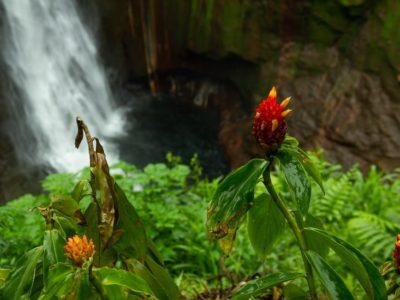
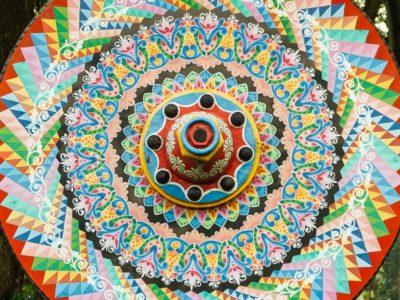
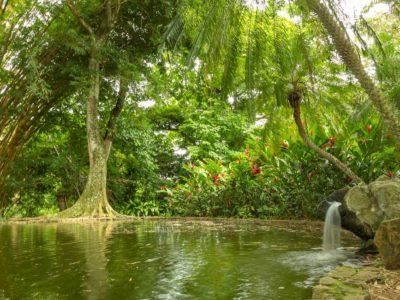
Gosh, the carving on those walls is amazing! Great post, lots of great tips! thank you!
Even more amazing when you think that it could be done only while the stucco was wet.
This is so beautiful! I would love to see the butterfly garden, it’s so gorgeous. And all the cool fun facts in this post were amazing! Thank you for taking us on your journey!
I haven’t been to any other museum where you find butterflies flying around the entrance. A testament to the ties of Costa Rica’s identity with nature!
Beautiful article… We love travelling and Costa Rica is on our bucket list, but you were right about seeing only the airport in San Jose. Thank you for changing my mind 🙂 I’m saving this post for future trip planning 😊
Glad it was useful for planning your future trips. Thanks for reading!